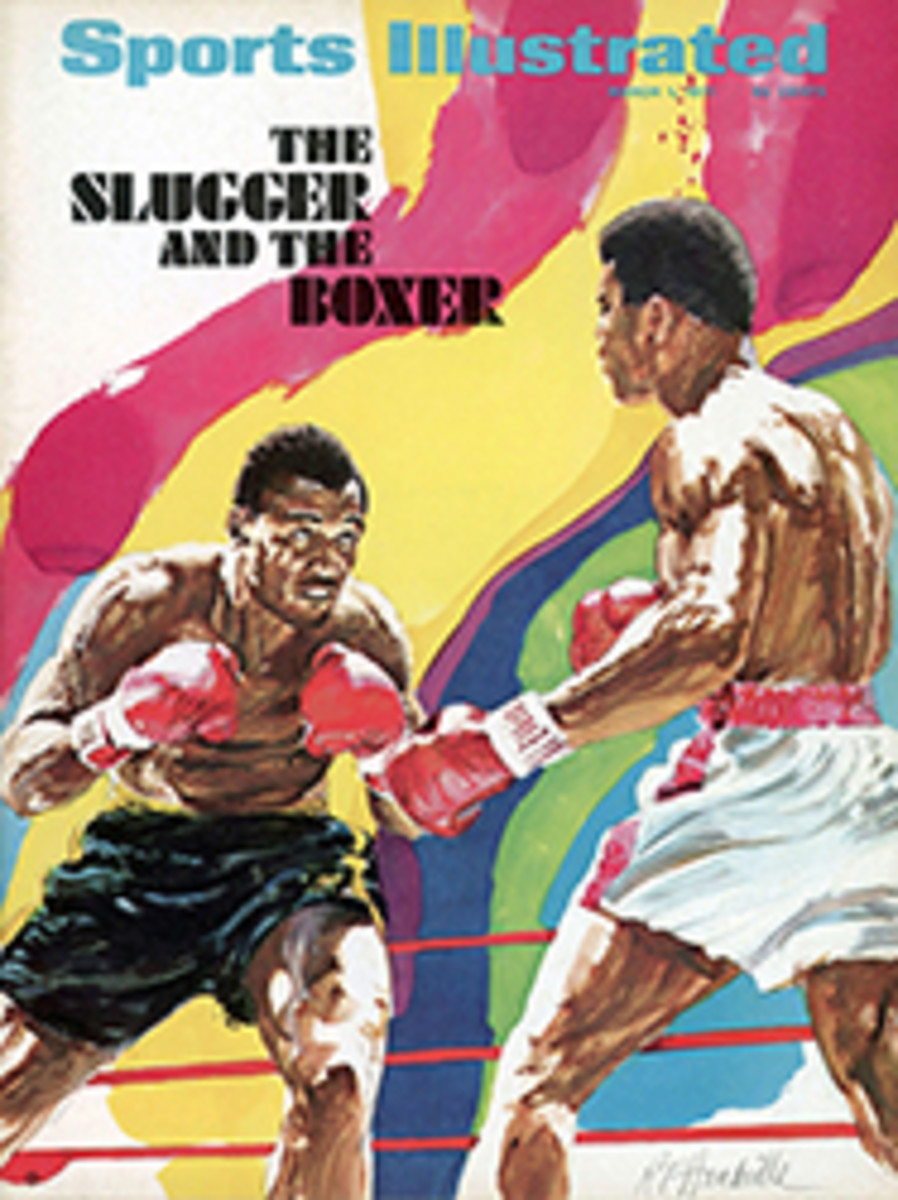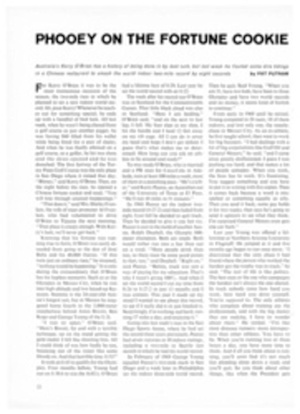
SCORECARD
IN A FUNK ABOUT THE DUNK
College basketball's dunk was dumped from the rules book in 1967 because it caused injuries to fingers and wrist, gave a special advantage to taller players and sometimes smashed up baskets and glass backboards. Now a movement is afoot to bring it back.
Guy Lewis, Houston Cougar coach, opposed the dunk ban from the beginning and is even more "violently opposed" to it today.
"It was the most exciting shot in basketball," he says, "and it hurt the game tremendously when they did away with it. I think the people on the rules committee are afraid to admit they made a mistake. The absence of the dunk removed a lot of the excitement from the spectator's point of view."
UCLA's John Wooden thinks the dunk is comparable to baseball's home run in producing excitement.
"When a big man does it, it's a crowd-pleaser," he says, "but when a little man does it it's a tremendous thrill."
There are coaches, though, who disagree. George Ireland of Chicago-Loyola holds that "the art of the game is shooting, not stuffing or jamming."
Without the dunk, he feels, "There are no delays of games, no injuries and no backboards broken."
But an Associated Press poll indicated that a majority of coaches want the dunk restored. And if the NCAA rules committee is listening, maybe it will be.
COUNSEL ON PHYSICAL FITNESS
Last week, for the first time since they were appointed in September, members of President Nixon's Sports Advisory Conference got together to attend a White House reception addressed by the President.
"I am not the best one to speak on this subject," Mr. Nixon told them quite frankly. "As a matter of fact...I really hate exercise for exercise's sake. Bud Wilkinson has constantly told me I must jog every day. I do a little, but about a minute is enough."
He went on to declare that it is no great disgrace if some people prefer to get their exercise vicariously.
"Let us face it," he said, "this is a sports-minded country. That isn't bad. It has a lot to do with the spirit of a country, the fact that people are interested in how a golf match or a football game or a baseball game or, for that matter, a tennis game comes out...that people who may not participate, who will never be champions, like to watch....
"With television and those marvelous closeups they have and the reruns and everything else, with television these days the tendency is for people just to sit there with feet up, eating pretzels and drinking—well, drinking, in any event—and that is their participation in sports. I do not think that is bad. As a matter of fact, that can do something for the spirit, as well—in both ways....
"I believe in competitive sports as a spectator or as a participant. I believe in the spirit that an individual develops either as he watches or as he participates in competition.
"I don't go along with the idea that all that really matters is jogging in place and having a good physical appearance. What really matters, of course, is the spirit as well as the body."
But then he promised that next morning he would jog two minutes.
GET A HORSE
In this era of the 7-foot basketball center, the 6'3" quarterback and the 250-pound tackle—even in high schools—the number of sports available to the average-size kid who isn't much taller or heavier than his father is dwindling fast. He can still run track, of course, and take part in baseball and soccer and tennis and lacrosse and wrestling—if his school happens to field teams in these sports—but there ought to be more.
In the high schools of the West there is more. In high school rodeo it's spirit rather than size that counts.
Take the Rio Grande High School Rodeo Club in Albuquerque, for instance. The 25 boy members average less than 145 pounds and the 10 girls on the team a mere 110. Yet they are winning trophies and being recruited by dozens of colleges that have rodeo scholarships.
As Pat Trujillo, agriculture teacher and team sponsor, says: "It is amusing to me to see boys who couldn't qualify for a third-string football team match their 145 pounds with 1,000 pounds of steer."
ALL IS CONFUSION
The Women's Liberation Movement has, at long last, come to Pocatello, Idaho, where Mrs. Nila Gilcrest, who is 31 years old, mother of two boys, attractive and redhaired, has applied for a job as an assistant football coach at Idaho State University.
"I'm sure," she said, "I could attract a lot of players to Idaho State."
Mrs. Gilcrest explained that she and her husband, Dr. Harry Gilcrest, an ophthalmologist, have been longtime football fans and that she has read a lot of books on coaching. She is, in fact, enrolled in a coaching class at Idaho State.
"I think it would be nice," she said, "to have someone to put her arm around a dejected football player and say, 'Honey, do it this way.' That'd get a lot better response than cursing."
And in Twin Falls, seat of the College of Southern Idaho—top-ranked junior college basketball team in the country—one of the team's cheerleaders, Becky Howard, took offense when a male student entered the contest for homecoming queen. She countered by entering the school's ugliest man contest.
Archie Quesnell, the male in the queen contest, finished only third.
But Miss Howard won.
TRIUMPH OF THE TRUMPETER
In 1912 ornithologists despaired of the survival of the trumpeter swan, noting that only several dozen existed on the entire North American continent. That was the year that an American, Ralph Edwards, created a homestead farm at remote Lonesome Lake in British Columbia and was delighted to find perhaps two dozen trumpeters feeding in small areas where the Atnarko River current kept the water from freezing over. In severe winters he chopped open their feeding areas and shared with them his chicken feed, hauled in on the backs of pack horses.
By radio last week came word from Edwards' daughter, Trudy Turner, that the count of the trumpeters had risen this year to 512—up 25% from the 1969-70 count of 418 swans. Along with the report came a plea to the Canadian Wildlife Service for an airlift of four tons of wheat to help the birds, largest of all waterfowl, get through the winter. The wheat was needed even though 18,000 pounds of grain had been packed in last October from Bella Coola, 72 miles away. Pilots of Wilderness Airlines began flying in the wheat at the rate of 1,000 pounds a flight—enough to care for the swans for four days at the sustenance rate of a daily half pound per bird. The swans are now far in excess of the number that could be supported by natural feed in the area.
A couple of years ago a continental census of the birds estimated their number at 5,000, with the largest known concentration at Lonesome Lake. In 1912 the ornithologists had declared that "the trumpeter's total extinction is now only a matter of years." But they reckoned without Ralph Edwards.
AT ODDS AT ASCOT
Snorting like the horses they wager on, brave British punters set out this past week to solve the problem of decimalization: to figure the odds and the payoffs under the strange new system of computing 100 pence to the pound. Up and down the country, at race meetings at Wolverhampton, Folkestone and Ascot, they were met by sympathetic and equally confused bookies. Standing in the ring at Ascot, a fistful of £10 notes in one hand and a pair of binoculars around his neck, Bookie Ted Sturman spoke for all his colleagues when he said, "Decimal odds are a load of rubbish. If punters want to bet any other way they will. But I think decimal betting will die out."
At Folkestone, Bookie Eddie Martin's experience was typical. He began by shouting the odds in decimals ("17 to 10 Viroy!") but soon reverted to the conventional way. "I laid only two bets at decimal odds," he said.
The tote, however, gave odds in decimals, and so did the big bookmakers from firms like Ladbroke's and William Hill. The latter passed out conversion cards to assist the punters.
"Decimal odds are worked out in either fifths or 10ths," sighed a spokesman for William Hill. "Old odds were usually to eight or four, like 13 to 8 or 7 to 4."
The conversion tables are not perfect, however. The old 7 to 4, for instance, becomes either 17 to 10 or 9 to 5 in decimals, and it is, in fact, not quite either. At Ascot some few punters with a gift for mental arithmetic were comparing the conventional odds offered by small bookies to the decimal odds of the large bookies on the rails and choosing the more favorable.
"You've got to be bloody quick to work it out, mind you," said Simon Channon, racing journalist, "but on a £10 bet you can get an extra 10 shillings at 13 to 10 over the conventional 5 to 4."
Confused or not, the punters continued to send the money in, according to the Hill and Ladbroke's firms, with little or no decline in business.
COACH ON THE COUCH
When it came to selecting a head coach the St. Louis Cardinals went all-out mod before settling on Bob Hollway, former defense coach of the Minnesota Vikings. Candidates were asked to go to Chicago and take industrial-psychology tests.
Dick Voris, defensive line coach for the Cards on the staff of former Head Coach Charley Winner, said he was not asked too many questions about football, but impressed a tester with his "drive."
"I was asked things like what didn't I like about my mother and father and what I thought of my children. I think the test was designed to determine if I was stable and how I would react to pressure. I was asked if I was socially inclined and what my hobbies were.
"None of the football questions had anything to do with winning or losing, but what I thought of our staff, whether I would let any assistants go.
"I would be for the test if it would help defenders get to the passer."
Winner, now a Redskin assistant, disclosed that the Cardinals previously had given tests to veteran players.
"We had the veterans tested first," he said, "because we wanted to see if the results of the test would match what we already knew about the players.
"They did not. The tests showed that some of our best athletes should not be playing football. Yet some had made All-Pro."
NO FAVORITES
Just before game time Bill Lear of the University of South Florida in Tampa discovered that his Saint Christopher medal was missing. So he asked the team manager to find him a replacement. Eric Saland gave it a try but finally had to settle for his Star of David medal. Lear wore it, and USF prevailed over Edison Junior College 122-120 in overtime.
ILLUSTRATION
THEY SAID IT
•Eddie Robinson, Grambling football coach: "My players can wear their hair as long as they want and dress any way they want. That is, if they can pay their own tuition, meals and board."
•Norman Hess, head keeper of mammals, Philadelphia Zoo, on some incidence of emphysema in the zoo: "It is thought that it is caused by air pollution since our animals certainly don't smoke."
•Phil Johnson, Weber State College basketball coach, on his 18-5 season record: "I don't think we've been beaten by officials more than five times this season."
•George Blanda, Oakland Raider quarterback: "The other day I got a call from Hollywood saying they wanted to do my life story. The only discouraging thing was that Walter Brennan was to play my part."

